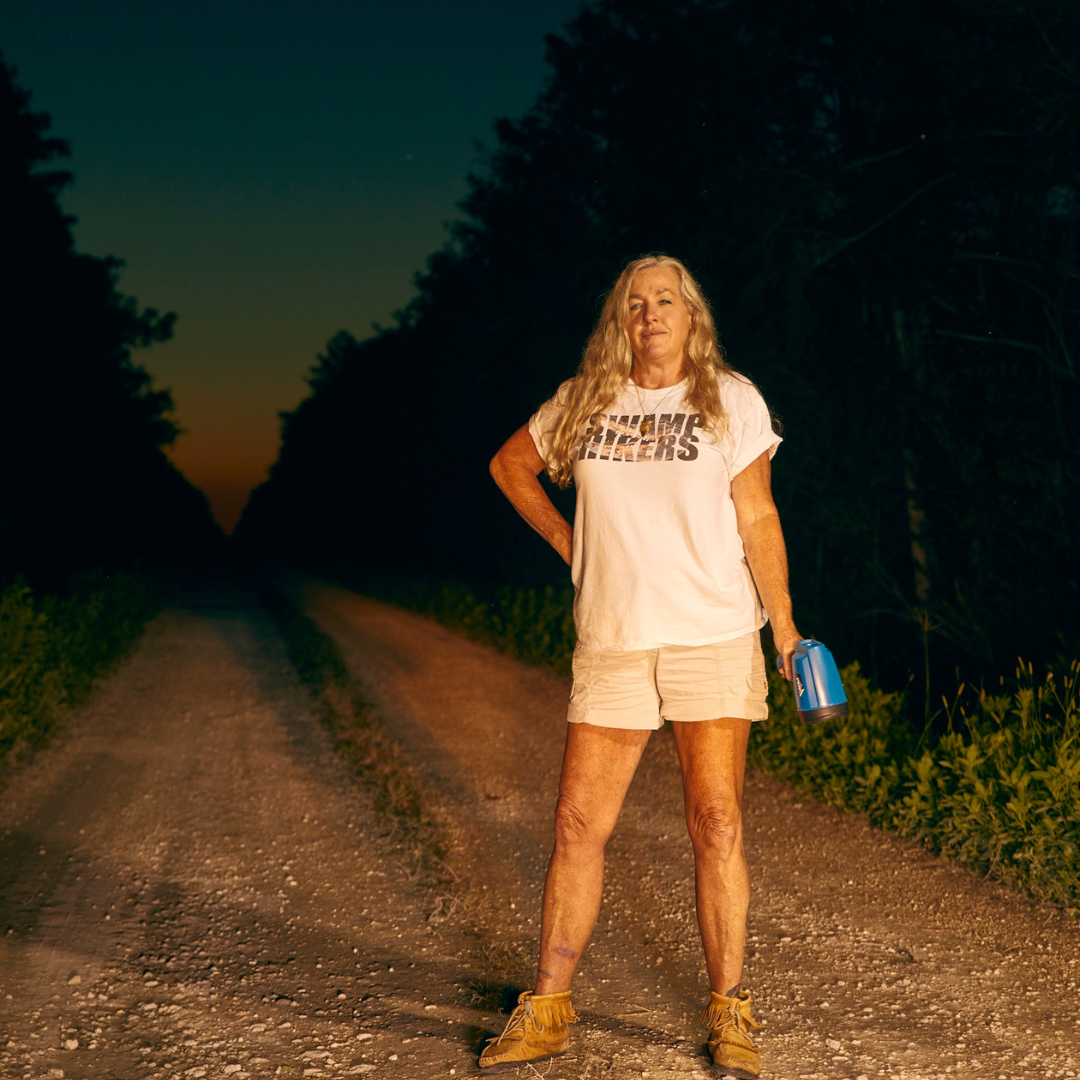by Katie Hendrick | February 26, 2018
Florida State of Mind
It’s impossible to point to one single icon that lays bare the diverse, rooted, complicated, beautiful, wacky soul of the Sunshine State. In our annual homage to those forces, past and present, that conjure the true spirit of our home—from Jim Morrison to Jimmy Buffett, from rum runners to running horses, from hurricanes to home runs and from natural springs to spring break—we take stock of the people, places and traditions that make Florida the greatest state on earth.


SURFING
Eleven-time world champion surfer Kelly Slater hails from Cocoa Beach, so it comes as no surprise that his hometown ranks among Florida’s most revered surf spots. To find it, just follow the billboards for Ron Jon Surf Shop that dot I-95 in both directions. Buffered by Cape Canaveral, Cocoa’s waves roll in small and gentle—perfect for groms ready to get their feet wet. More seasoned shredders line up south of the Ponce de Leon Inlet at New Smyrna Beach, which consistently sees waves in the two- to three-foot range, or up at Jacksonville’s North Jetty at Huguenot Park, where longboarders like Justin Quintal can ride long, peeling right-handers. “On a big hurricane swell, the jetties can have a really epic wave for shortboarding too,” says Evan Thompson, a former member of the USA Surf Team and owner of Thompson Surf School in Jacksonville Beach, bragging on his all-time favorite surf spot. For an exceptional view, visit Playalinda Beach, situated in the Canaveral National Seashore, with a clear line of sight to NASA’s launch pad. Want to watch the sport’s all-stars and up-and-comers in action? Check out Sebastian Inlet, a favorite break for professional and amateur competitions alike. Honorable mentions go to first Street in Miami’s South Beach and Reef Road in
Palm Beach.


THE GREATEST SHOW ON EARTH
John Ringling’s decision in 1927 to move his circus’s winter headquarters from Bridgeport, Connecticut, to Sarasota brought the once-sleepy Gulf Coast community national acclaim, economic prosperity and the most fascinating snowbirds the state has ever known. Tightrope walkers, trapeze artists, fire-eaters, sword-swallowers, giants, midgets, contortionists, strongmen and exotic animals galore drew hundreds of thousands of visitors, many of whom fell in love with the area in the process. “Sarasota’s growth has everything to do with having housed this huge entertainment center in our backyard,” says Deborah Walk, a circus curator for the John and Mable Ringling Museum of Art. Cecil B. DeMille immortalized the town and its unique institution with The Greatest Show on Earth, the winner of the 1952 Academy Award for best picture, starring Charlton Heston, James Stewart and dozens of actual circus performers, including Emmett Kelly the clown and aerialist Antoinette Concello. In 1959, the Ringling Bros. and Barnum & Bailey Circus moved to nearby Venice, where it stayed until 1992, when it was relocated to Tampa. The 146-year-old company ended its run in May 2017, but its legacy lives on. In addition to a 23,000-square-foot circus exhibition space and a 3,800-square-foot miniature circus at The Ringling, Sarasota is home to Big Cat Habitat, a sanctuary that provides a home for retired circus lions and tigers; the Circus Ring of Fame at the St. Armands Circle; and the Circus Arts Conservatory, which presents one-ring, five-star performances a few weeks a year, trains young gymnasts and provides humor therapy for the elderly and the infirmed. There’s also Bob’s Train, a cafe built in an old Ringling railcar, a favorite breakfast spot of old performers. Says Walk, “The death of the circus has been greatly exaggerated.”


TALES OF OLD FLORIDA
Anyone nostalgic for a Florida before theme parks, timeshares and traffic took over must read A Land Remembered (Pineapple Press, 1984). Patrick Smith’s best-seller—available this spring as a graphic novel adapted by Andre Frattino—follows three generations of ranchers from the Civil War to the civil rights movement as they battle myriad adversaries including alligators, mosquitoes, hurricanes, freezes, rustlers and developers.
More Must-Reads
The Yearling (1938), by Marjorie Kinnan Rawlings
Oranges (1975), by John McPhee
Tourist Season (1986), by Carl Hiaasen
Shadow Country (2008), by Peter Matthiessen
SPRING TRAINING
Each February, the 15 Major League Baseball teams belonging to the Grapefruit League, named for the state’s beloved citrus crops, set up camp in various Florida cities to work out the kinks in warm, sunny environs before opening day. The first instance of spring training in Florida occurred in Jacksonville in 1888, when Cornelius Alexander McGillicuddy, record holder for career wins as a manager (and grandfather of former Senator from Florida Connie Mack III), was just a reserve catcher for the Washington Nationals. It took nearly 30 years, however, for team owners to recognize the Sunshine State’s marketable appeal and cement a tradition of play that now draws 1.5 million spectators over the course of just 37 days. The teams’ adopted cities pull out all the stops to make visitors feel at home. Some stadiums even offer local delicacies at concession stands—think lobster rolls for the Red Sox, cheesesteak for the Phillies and poutine for the Blue Jays.
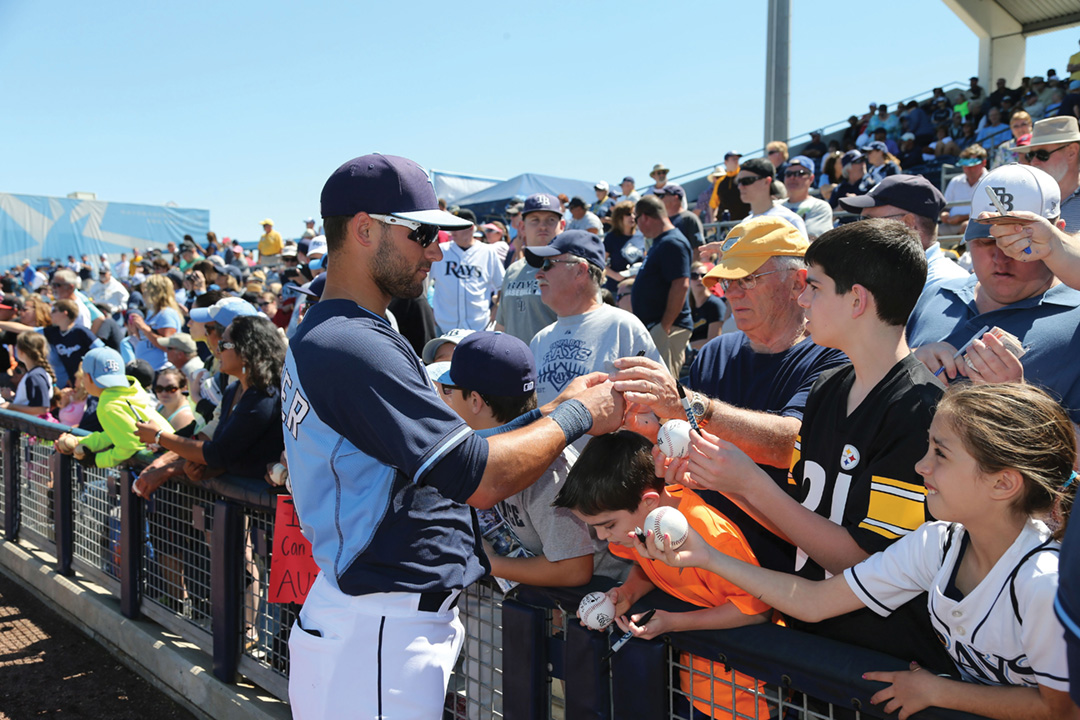

SPRING BREAK
An annual college swim camp in the 1930s introduced students to the allure of Fort Lauderdale’s balmy respite in the middle of the semester, but it was the performances of a hunky George Hamilton and coquettish Dolores Hart in 1960’s Where the Boys Are that really catapulted the collegiate rite of spring break. The year following the movie’s release, 50,000 coeds descended on the South Florida city, a phenomenon that initially delighted locals appreciative of the economic boost. In the ensuing decades, however, enthusiasm waned as students’ behavior devolved. Fed up with beach brawls, trashed hotels and binge drinking, Fort Lauderdale’s mayor chased the young ’uns north in an appearance on national television in 1986 (about the time Revenge of the Nerds II: Nerds in Paradise wrapped up filming) alongside Daytona’s mayor, who promised to welcome revelers with open arms. Fueled by the attention of a partnership with MTV, Daytona’s version of spring break grew even bigger, badder and more publicized. But Daytona too soon tired of gridlock and grisly alcohol-fueled accidents. It severed ties with the network in 1993 and cracked down on drinking laws. The party subsequently moved to the Panhandle, where Panama City Beach officials and residents now contend with the same frustrations as their predecessors. The 2016 documentary Spring Broke captures the story in salacious detail. In response to the boozing coeds, Panama City Beach banned drinking on the sandy beach throughout last March. For now, it seems Spring Breakers still have Key West—until
they don’t.
NARURAL SPRINGS
Florida has 43 official natural springs sites across its northern and central regions, where tepid water temperatures hover around 70 degrees year round, more than any other state in the nation. The crystal-clear, turquoise waters of Florida’s springs have graced the silver screen for decades, appearing in several installments of the James Bond and Tarzan franchises, as well as 1954’s Creature From the Black Lagoon. The latter was filmed in part at Wakulla Springs, 14 miles south of Tallahassee, which boasts one of the state’s most storied hotels on its premises. In 1937, millionaire businessman Edward Ball developed the Wakulla Springs Lodge, a retreat replete with opulent details such as an art deco–style walnut-walled elevator, a hand-painted ceiling depicting local wildlife and a marble soda fountain counter that stretches more than 70 feet. The inn features 27 spacious rooms with vintage furniture, the grandest of which overlook the springs. It also pays homage to a former neighbor Old Joe. More than 50 years after his death in 1966, the 11-foot, 650-pound alligator now rests stuffed and mounted in a glass coffin in the lobby.
CATTLE RANCHERS
Cattle arrived in St. Augustine in the 1500s, imported by Spanish conquistadors who then abandoned their herds as they traveled the state. The Seminole tribe began domesticating and breeding them, followed by pioneer settlers. At first a means of survival, ranching has grown into an $847 million industry and a gratifying way of life for its stewards. “It develops deep bonds, with the land and within families,” says Doyle Carlton III, a fifth-generation rancher in Wauchula, whose earliest memories involve tottering behind his father and grandfather as they worked their herds deep in Central Florida. His experience has come full circle, as his children and grandchildren have embraced the vocation, too. Says Carlton, “It’s our love.”
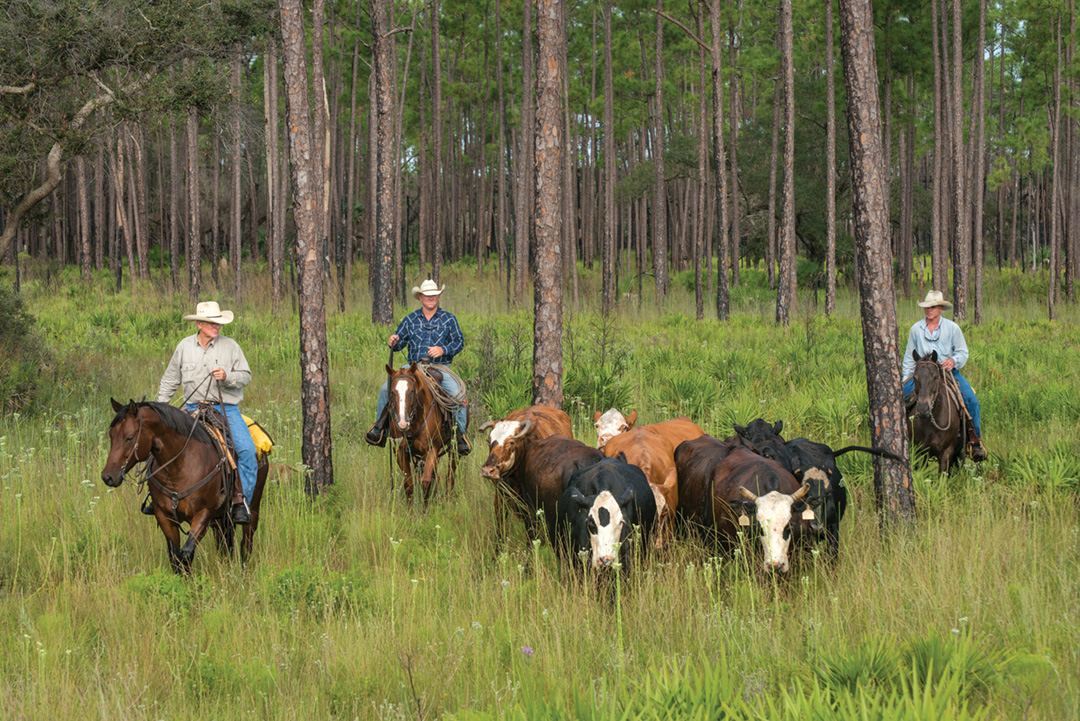

FLA 101
Don’t get caught not knowing the state stuff, like our song, “Swanee River.” Here’s our cheat sheet of the official state symbols you forgot you learned in school.


HORSE HEAVEN
While developing Florida’s road system in the early 1900s, a contractor discovered a wealth of limestone (an element that often underlies rich grasslands) beneath Ocala, recognized the region’s potential as an equestrian haven and established the first thoroughbred farm in Florida. Today, 431 farms cover more than 70,000 acres in the Ocala area. Needles was the first Florida-bred racehorse to win a race of this caliber, and his 1956 Kentucky Derby victory propelled the North Florida city, population 59,000, to the upper echelon of horse racing. Since then, it has produced 50 national champions, 26 Breeders’ Cup winners and American Pharaoh, the last Triple Crown winner. It’s also served as the winter training ground for countless others. “That’s just the tip of the iceberg,” says local breeder Wendy Christ, who helps rehome retired racers. “Here, you’ll find every type of horse doing every discipline, from dressage to barrel racing. They even play a therapeutic role with our prison inmates. They’re versatile animals with so much heart.”
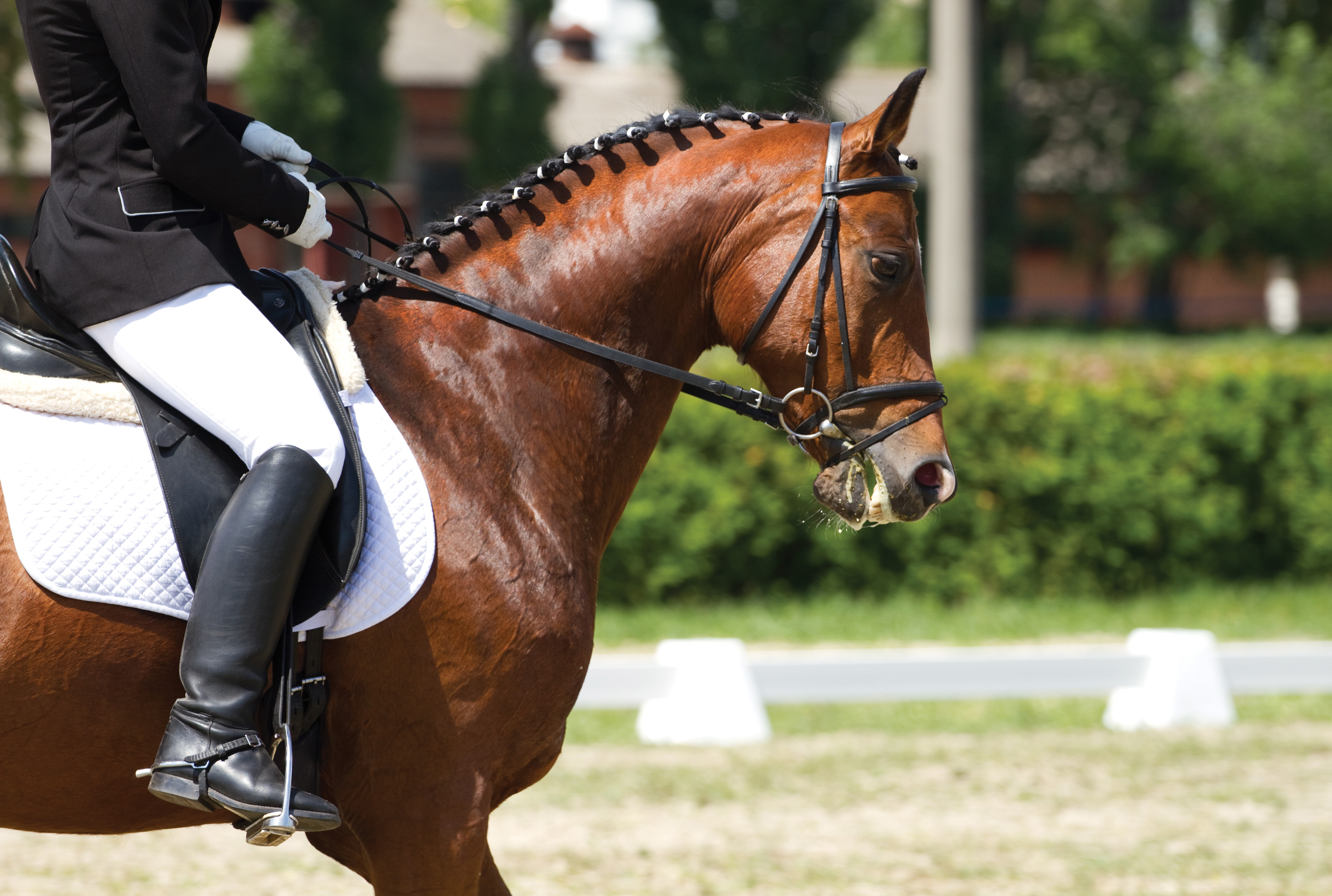

ACTS OF GOD
Life on the peninsula is not always as idyllic as the postcards suggest. Though millions of residents dodged the utter devastation Irma inflicted on the Keys in 2017, Floridians acknowledge the destructive power of hurricanes and spend six months a year in fear of the next Donna, Andrew or Charley. Storms form to offset exceptionally warm water, explains Dave Osterberg, a meteorologist for Tampa’s Fox 13. “Ultimately, they want to go to the poles. However, Florida—like North Carolina’s Outer Banks—juts out into their path, so we get hit a lot,” he says. Another unsettling concern: the chance that the earth could open up and swallow whole neighborhoods. Both natural phenomena (torrential rain) and human activity (spraying crops, showering, drinking water) can trigger sinkholes. When the aquifer beneath us gets low, empty space is created between rocks beneath the surface, and the heavy ground on the surface collapses. The most prevalent danger in the state, however, is lightning. Florida is narrow enough that sea breezes from the Gulf and the Atlantic meet in violent collisions that can release up to one billion volts of electricity. “We lead the nation in lightning strikes and, unfortunately, deaths [from lightning strikes] because people don’t take warning signs seriously,” Osterberg says. “If thunder roars, get indoors.”


OSCEOLA TURKEY
Found only in Florida—south of the Suwannee River, specifically—the Osceola turkey is the ultimate challenge for hunters in pursuit of the elusive grand slam of turkey hunting. “Of the country’s four subspecies, it’s by far the hardest one to get,” says John Nash, a Bradenton resident and retired banker who’s hunted the birds for 50 years. That’s largely because the birds tend to roost on private land. The wary gobblers are also very alert to movement, and fast—flying at speeds of 55 mph—so hitting one “requires the patience of a chess master,” Nash says. To find them, he recommends consulting an outfitter, such as Florida Outdoor Experience in Chiefland, which has five turkey farms and specializes in upscale hunting experiences.


THE RUM RUNNER
In 1972, the owner of the Holiday Isle Tiki Bar in Islamorada noticed an overstock of liquor and challenged his manager to concoct something special to purge it. Enter: the rum runner. Named for the bootleggers who carted booze from the Caribbean to Florida during Prohibition, this sweet but potent libation features light and dark rum, banana and blackberry liqueurs, orange and pineapple juices, and a splash of grenadine. More than 45 years later, it endures as a quintessential tropical treat. Martin Kucera, head bartender at the nearby Morada Bay Beach Cafe & Bar, fields rum runner requests constantly. “Travelers from across the globe always ask whether we know how to make a real one,” he says. Among them: a man who previously smuggled Gosling’s rum between Bermuda and various locales along the East Coast. “While those days are long behind him, he still visits us every few years requesting a rum runner,” Kucera says. “We consider this the highest form of flattery—to have a stamp of approval from a true rumrunner himself.”
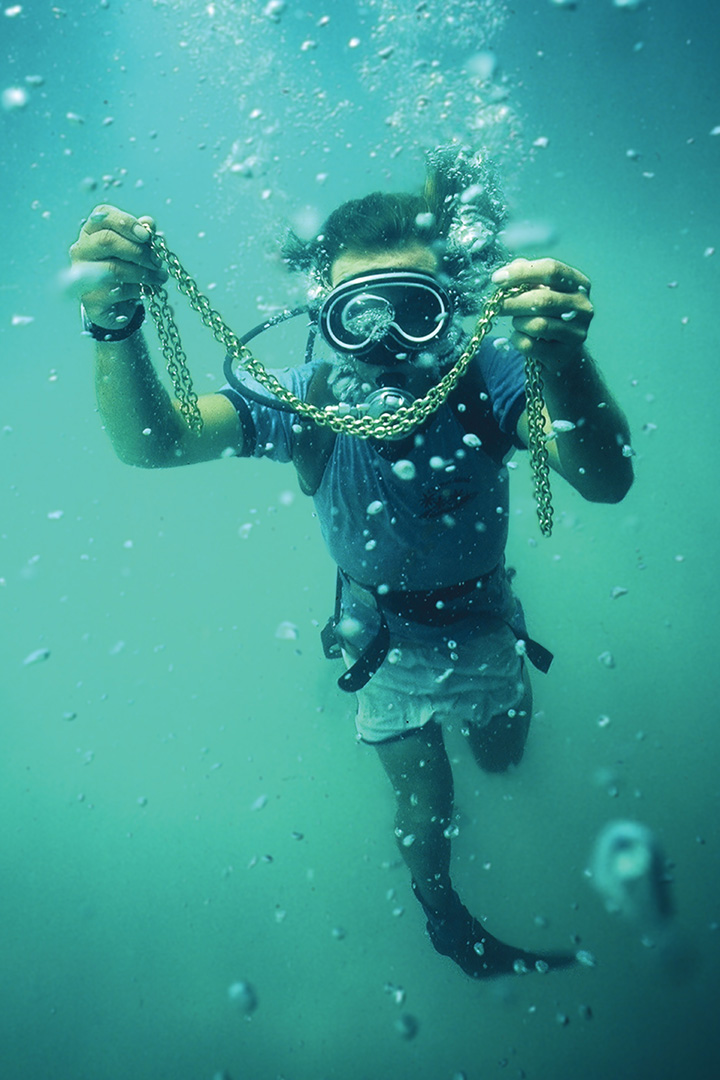

TREASURES UNTOLD
A poorly timed departure put the Nuestra Señora de Atocha in the path of a hurricane on its voyage home from Cuba to Spain. The doomed galleon, loaded with gold, silver and jewels from South America, made it only as far as the Marquesas atoll, where it remained undisturbed, 55 feet below the surface, from Sept. 5, 1622, until July 20, 1985, when the late treasure hunter/eternal optimist Mel Fisher’s mantra—“Today’s the day!”—came true, big time. Relying on vague 17th-century documents from Spaniards who located the Santa Margarita, the Atocha’s sister ship, Fisher and his crew found the wreck after 16 years spent doggedly searching. (He’d previously salvaged the 1715 Fleet, which sank near Vero Beach and earned the area the moniker “Florida’s Treasure Coast.”) Today, Fisher’s son, Kim, and daughter, Taffi, carry the torch as leaders of the Mel Fisher Family Enterprises, overseeing a conservation center, two museums (the Mel Fisher Maritime Museum in Key West and Mel Fisher’s Treasure Museum in Sebastian), stores in both cities (authentic Atocha coin jewelry retails at anywhere from $1,200 to $32,850) and two 90-foot vessels that take investors on salvage dives at wrecks. “There’s still a lot left to be recovered,” says Megan McDowell, marketing director for Mel Fisher’s Treasures. “Between the Atocha and the Margarita, there’s at least $300 million worth of treasure that we know of.”
THE SUNSHINE SOUND
Few musicians could be more iconic to Florida than our adopted musical sailor, Jimmy Buffett, with his songs about flip-flops and pop-tops. Buffett took to the stage in Key West in 1971 to chase his dreams of becoming a musician. The 71-year-old passed out, rallied, sprung a few leaks and, oh yeah, created a billion-dollar brand out of Margaritaville along the way.
Anyone who’s attended a movie, major sporting event or wedding in the past 43 years has heard KC and The Sunshine Band. To many, the Grammy-winning group, best known for “Get Down Tonight,” “That’s The Way (I Like It)” and “Boogie Shoes,” personifies the lively rhythm of the disco era. But to founder Harry Casey, the music embodies South Florida’s multiethnic culture. Growing up in Hialeah exposed him to various musical genres, including pop, reggae and Latin, which he commingled into his legendary “sunshine sound.” Grateful for his roots, he’s never moved farther than 10 miles away from his hometown. Another sunny icon, Gloria Estefan, fluent in Spanish, English and French, started out as a translator in the customs department at Miami International Airport, where CIA officials once approached her, suggesting a career in espionage. Instead, she became a celebrated chanteuse whose many accolades include three Grammy Awards, the Presidential Medal of Freedom, membership in the Songwriters Hall of Fame and Kennedy Center Honors. Jim Morrison, born in Melbourne, briefly attended Florida State University before honing his psychedelic blues style in California. The front man for the Doors caused a stir back in his home state during a 1969 concert at the Dinner Key Auditorium in Miami, where he allegedly exposed himself and shouted various obscenities at the audience, leading to his arrest. The troubled troubadour died two years later at age 27; in 2010, Governor Charlie Crist granted him a posthumous pardon.
A day trip to Ocala in 1961 set in motion an illustrious career for Tom Petty. There, the 11-year-old Gainesville native saw Elvis Presley filming Follow That Dream and vowed to become a star himself. With four friends, he formed a band called Mudcrutch (the precursor to the Heartbreakers), which played regular gigs at Dub’s, a local topless bar. The Rock & Roll Hall of Famer died last October, just 18 days shy of his 67th birthday. Since then, University of Florida fans have memorialized their hometown hero by singing one of his hits, “I Won’t Back Down,” at sporting events. And then there’s Ray Charles, whose most famous song often leads people to believe he lived his whole life in Georgia. But he moved to Florida as an infant and grew up there, attending the Florida School for the Deaf and the Blind in St. Augustine. At the school, Charles learned to read, write and compose music in braille.


MERRITT 43
Though only 12 of its kind were ever built, the Merritt 43 made quite a splash when it debuted in 1968. Named for its length, the custom design from Merritt’s Boat & Engine Works in Pompano Beach has helped anglers achieve numerous records, including the men’s all-tackle Atlantic and Pacific blue marlin records, the women’s all-tackle Atlantic blue marlin record, and the record for most giant bluefin tuna caught in one day. “It was the right boat at the right time—bigger than most, yet light and nimble,” says CEO Roy Merritt, a third-generation builder in the family business. Salt Water Sportsman declared it a “game-fishing weapon” and “the top sport fishing boat of all time,” while Power & Motor Yacht praised its clean aesthetics, even going so far as to call it “prettiest.”


PUBLIX
Floridians (and grocery shoppers across the Southeast) love the state’s iconic supermarket chain. Lakeland-based Publix, which operates more than 1,000 stores, owes its sterling reputation to founder George Jenkins. Nearly nine decades ago, Jenkins envisioned a store “where shopping is a pleasure,” and the company’s 188,000 associates are invested in upholding his standards today. Publix is one of the largest employee-owned companies in the world. A generous employee stock ownership plan has created a loyal workforce of people who stick with the company for decades, developing rich, first-name relationships with customers along the way, explains spokesperson Maria Brous. “Food is at the center of so many occasions, which means we get to celebrate countless milestones with people,” she says. “It’s a privilege we cherish.”
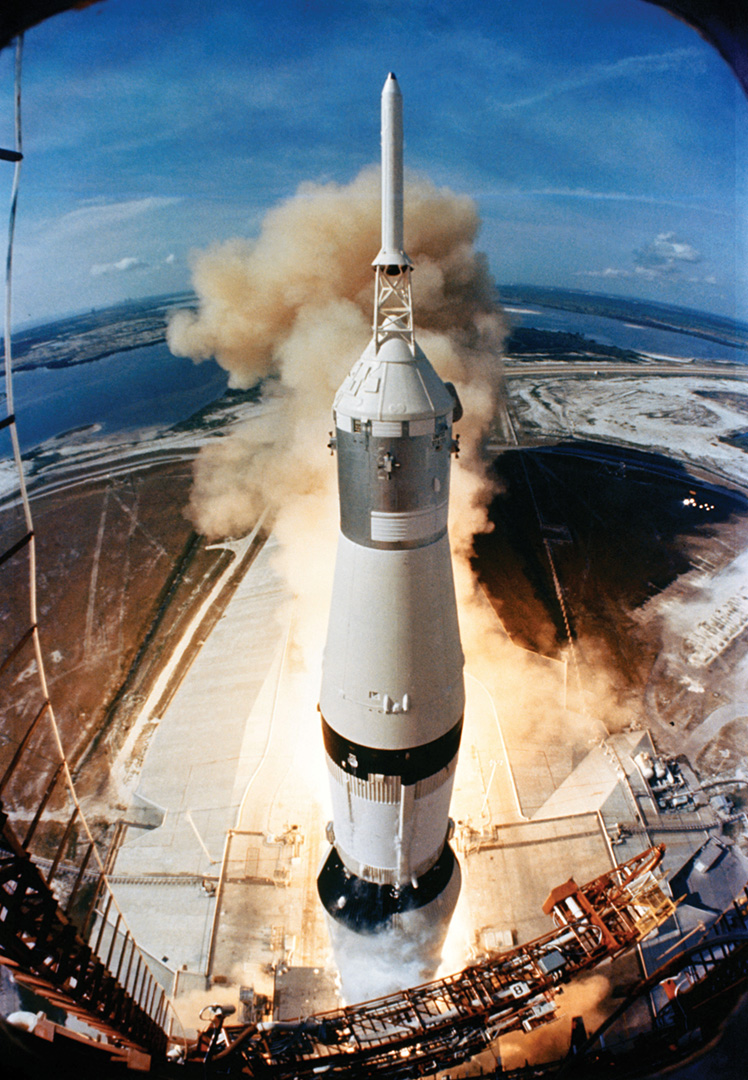

EVENTS THAT CHANGED THE WORLD
In the last decade, waves of national news have poured out of Florida—including the trials of Casey Anthony, accused of murdering her two-year-old daughter, and George Zimmerman, the neighborhood watch
member who fatally shot an unarmed Trayvon Martin, as well as the Pulse shooting, in which 49 Orlando nightclub patrons perished. Despite these tragedies, Floridians found a way to gain strength, resolve and voice, whether rallying around victims or protesting injustices. But there’s no denying that the Sunshine State has been ground zero for several watershed moments (bad and good) in U.S. history. Families huddled around television sets on July 16, 1969, to watch Neil Armstrong, Michael Collins and Buzz Aldrin board Apollo 11 in Cape Canaveral. Flash-forward to Feb. 6, 2018 when spaceflight took another leap with SpaceX’s rocket, Falcon Heavy, which launched from the same launch pad as Apollo 11.
The image of an armed U.S. immigration agent confronting terrified 6-year-old Elián González tugged at the nation’s heartstrings, earned Miami photographer Alan Diaz a Pulitzer Prize, paved the way to normalizing relations with Cuba and, some scholars speculate, influenced Floridians’ votes a few months later during the 2000 presidential election imbroglio—arguably the state’s brightest turn in the spotlight. Who can forget those 36 angst-filled days of manual recounts, legal battles and special legislative sessions?
Florida has changed the world in so many ways. We had the first Native American casino, first national wildlife refuge and a court case (Gideon v. Wainwright) that established a defendant’s constitutional right to an attorney. In addition, it was Martin Luther King Jr.’s visit to St. Augustine that finally shamed Congress into passing the Civil Rights Act of 1964. For requesting a meal at the Monson Motor Lodge, King was handcuffed and hauled off to jail. Days later, a group of black and white protesters held a “swim-in” by jumping into the Monson’s pool, prompting its enraged owner to pour muriatic acid in the water—an act captured by network and wire service photographers. The story blew up, and two weeks later, President Lyndon Johnson signed the bill into law.
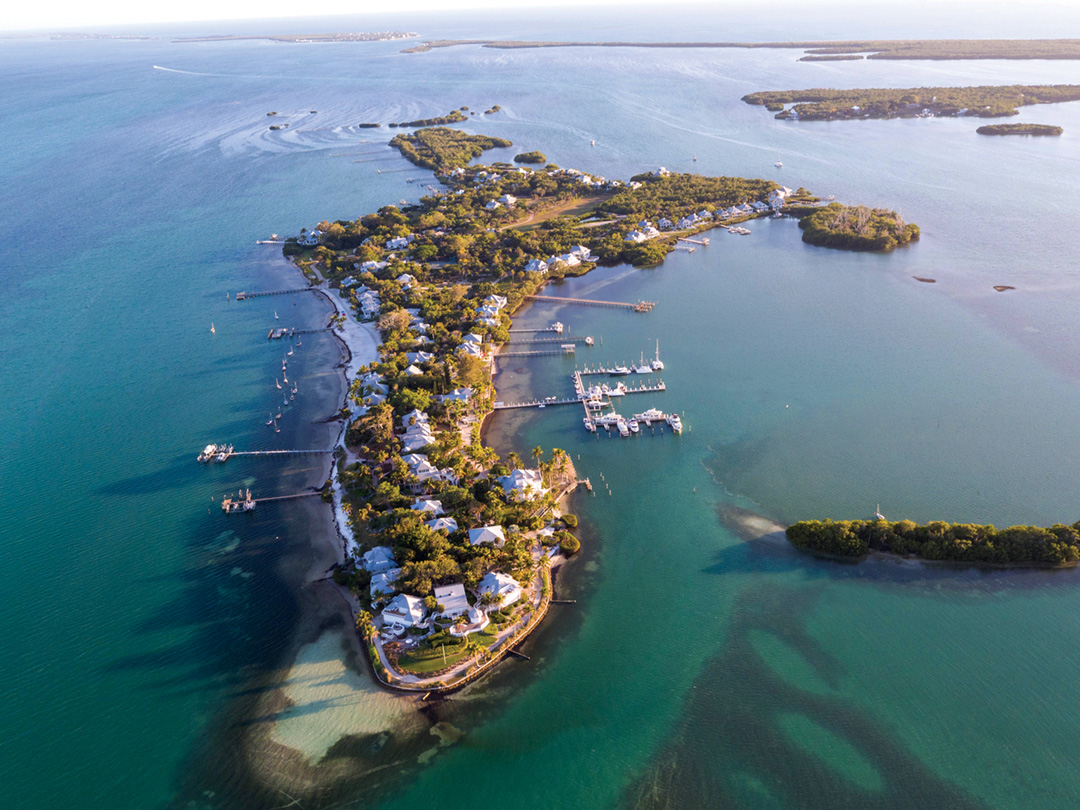

CLUB PARADISE
Tourists (more than 100 million in 2017) pose a challenge for locals who want to enjoy Florida’s stunning scenery and some personal space. However, there remain a few places around the state where you can luxuriate in peace. Private enclaves, such as the Jupiter Island Club in Jupiter, Ocean Reef Club in Key Largo and Bokeelia’s Useppa Island Club, provide sanctuaries from the crowds and preserve the Old Florida lifestyle. Useppa, formerly home to Chicago streetcar magnate John Roach and then advertising-executive-turned-behemoth-developer Barron Collier, can only be accessed by boat, seaplane or helicopter, keeping the island free of combustion from vehicles. Its 700 members—100 of them residential—have plenty of recreational options at their disposal, including fishing, boating, shelling, golfing, shopping, kayaking, paddleboarding, croquet and tennis. “Useppians can be as active or carefree as they please,” says Sales Manager Rogan White. “The art of the ‘Florida nap’ may have been perfected underneath one of our island’s many royal palms or heritage oaks.”



